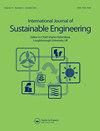Potential applications of Post-Consumer Vinyl Flex Banner (PCVFB) materials: sustainable management approach
IF 3.6
Q3 GREEN & SUSTAINABLE SCIENCE & TECHNOLOGY
International Journal of Sustainable Engineering
Pub Date : 2021-11-02
DOI:10.1080/19397038.2021.1998841
引用次数: 1
Abstract
ABSTRACT In the present review, the consideration has paid on various possible applications of post-consumer polyvinyl chloride flex banners (vinyl flex banners), focusing on their process chemistry, process parameters, and methodologies. The vinyl flex banners are mainly composed of calcium carbonate, polyvinyl chloride resin, polyester fabric, plasticisers and additives. From the intensive literature search, it is observed that post-consumer vinyl flex banner (PCVFB) materials have the potential to use in various fields. The PCVFB materials can be reused as received for various possible applications, such as water-proof roof covers, vehicle covers, food grain covers, tarpaulins, sitting mats, bags, etc. Critically, they can be recycled by using suitable preparation process for different applications, such as footwear, geotextiles, canal linings, ropes, and pipes. Further, the PCVFB material can be used as one of the ingredients for concrete materials. To the finest of our information, it can be further suggested that there is a scope to prepare low-cost wood-plastic composites (WPC), and adhesive/glue material from PCVFB for diverse applications. The use of PCVFB for various possible applications can reduce the accumulation of solid waste and can provide a cleaner and greener environment. Graphical Abstract消费后乙烯基柔性横幅(PCVFB)材料的潜在应用:可持续管理方法
在目前的回顾中,考虑了消费后聚氯乙烯柔性横幅(乙烯基柔性横幅)的各种可能的应用,重点是它们的工艺化学,工艺参数和方法。乙烯基柔性横幅主要由碳酸钙、聚氯乙烯树脂、聚酯织物、增塑剂和助剂组成。从密集的文献检索中,可以观察到,消费后乙烯基柔性横幅(PCVFB)材料具有在各个领域使用的潜力。PCVFB材料可以重复使用,用于各种可能的应用,如防水屋顶盖,车辆盖,粮食盖,防水油布,坐垫,袋子等。重要的是,它们可以通过使用合适的制备工艺进行回收,用于不同的应用,如鞋类、土工织物、运河衬里、绳索和管道。此外,PCVFB材料可作为混凝土材料的配料之一。据我们所知,可以进一步表明,从PCVFB中制备低成本木塑复合材料(WPC)和粘合剂/胶水材料用于各种应用是有可能的。在各种可能的应用中使用PCVFB可以减少固体废物的积累,并可以提供更清洁和更环保的环境。图形抽象
本文章由计算机程序翻译,如有差异,请以英文原文为准。
求助全文
约1分钟内获得全文
求助全文
来源期刊

International Journal of Sustainable Engineering
GREEN & SUSTAINABLE SCIENCE & TECHNOLOGY-
CiteScore
7.70
自引率
0.00%
发文量
19
 求助内容:
求助内容: 应助结果提醒方式:
应助结果提醒方式:


